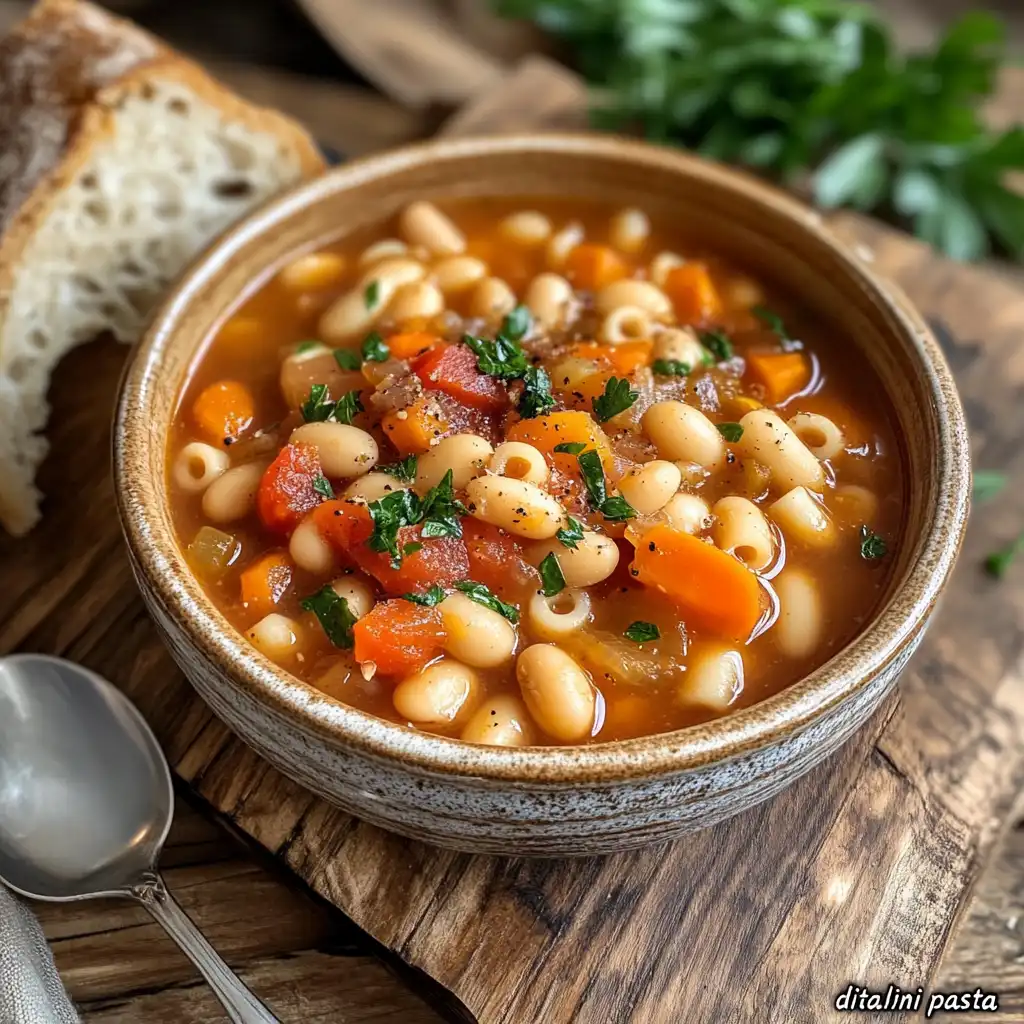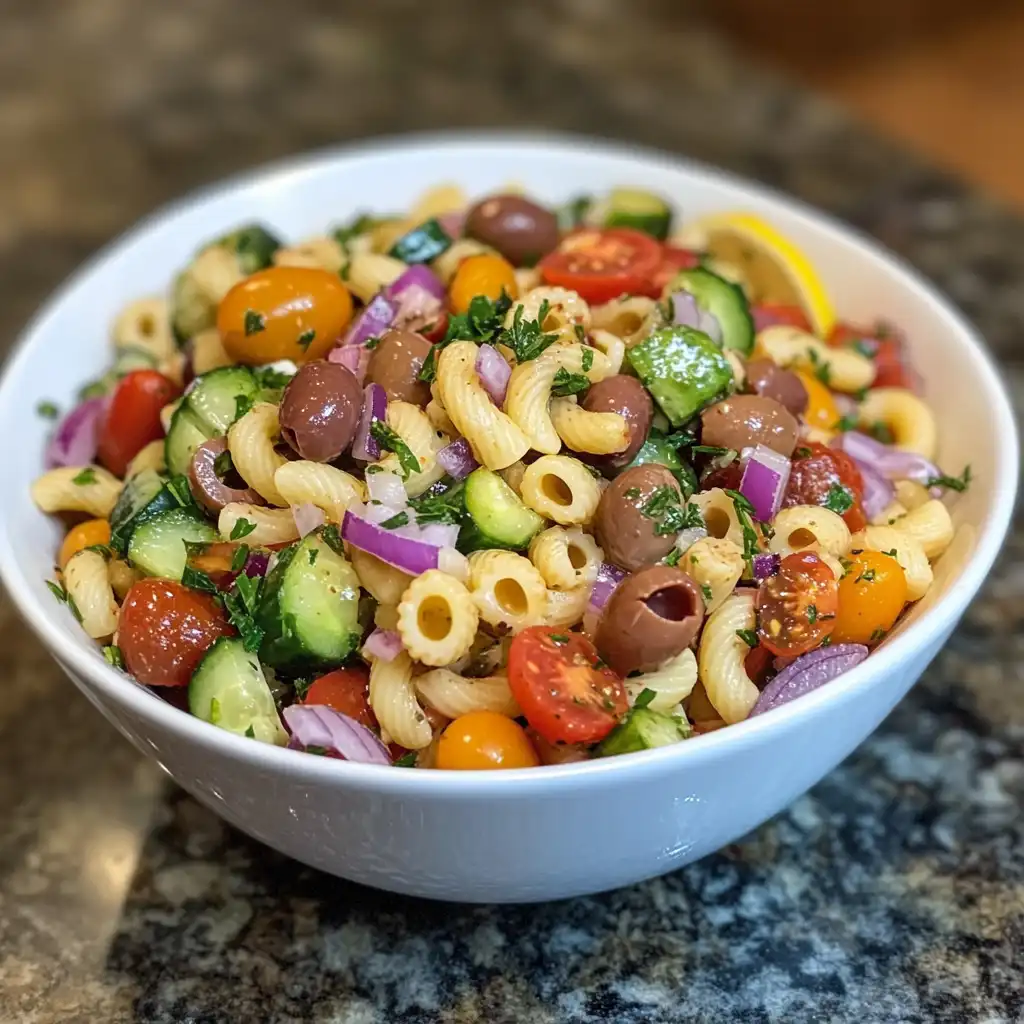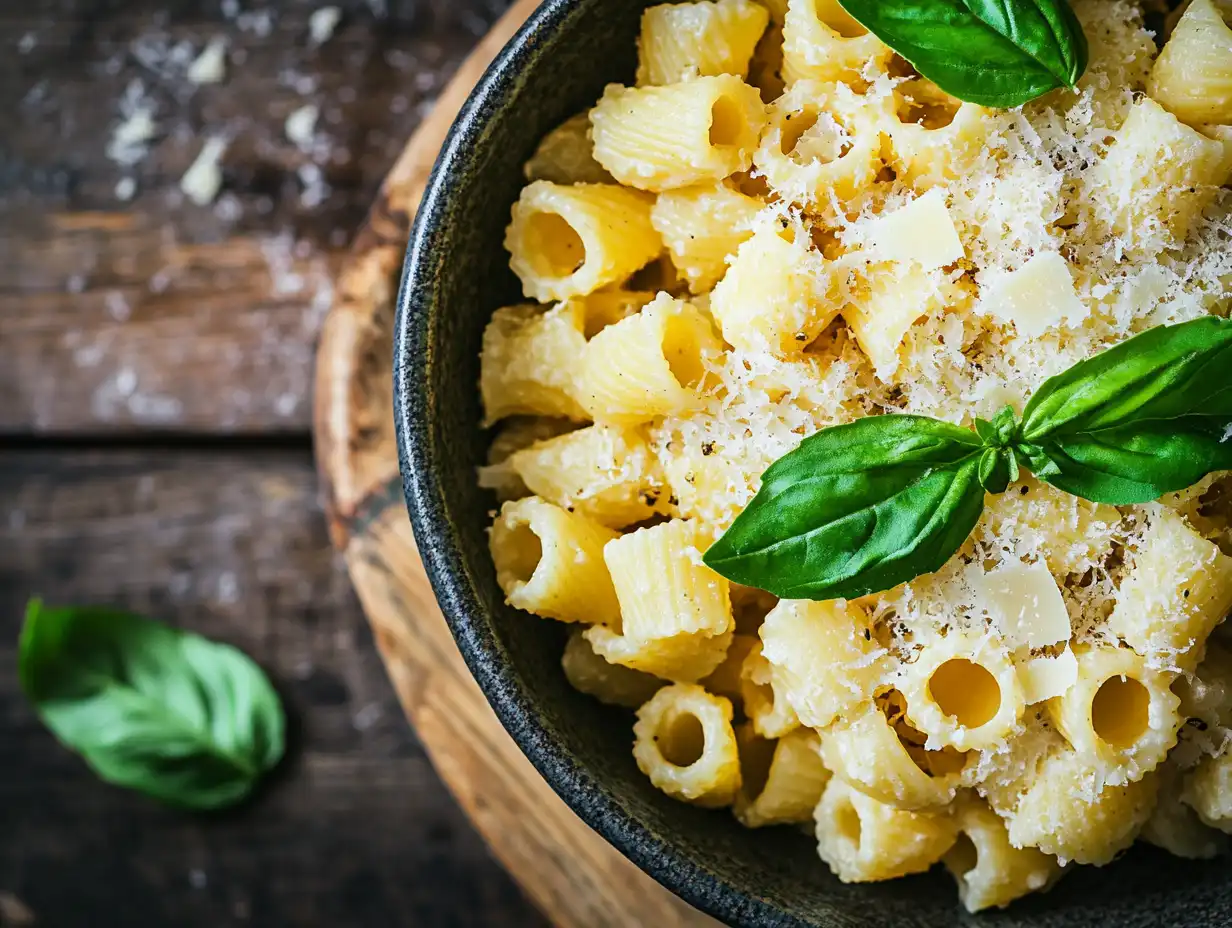Introduction
Ditalini pasta, characterized by its small, tube-like shape, has been a beloved staple in Italian kitchens for centuries. This versatile ingredient, whose name translates to “little thimbles,” plays a starring role in many traditional recipes, particularly soups and broths. Despite its ancient roots, ditalini continues to gain popularity worldwide due to its adaptability and delightful texture.
From hearty dishes like pasta e fagioli to refreshing pasta salads, ditalini’s shape makes it a perfect choice for recipes that require uniformity and consistency. Its ability to soak up flavors while maintaining its structure is what truly sets it apart.
In this article, we’ll explore the fascinating history, cooking techniques, and endless recipe possibilities of ditalini pasta. Whether you’re a seasoned chef or a home cook, this guide will inspire you to elevate your meals with this delightful ingredient.
History of Ditalini Pasta
The Etymology of “Ditalini”
The name “ditalini” derives from the Italian word ditale, meaning “thimble.” This fitting description reflects its diminutive, cylindrical shape that resembles a tiny sewing thimble. Adding the suffix -ini emphasizes its small size, translating directly to “little thimbles.”
Origins in Italy: Regional Uses
Ditalini pasta traces its roots to Southern Italy, particularly in regions such as Campania and Sicily. Here, pasta is more than a food—it’s a cultural symbol. In these areas, ditalini was traditionally used in cucina povera, or “poor cuisine,” a style of cooking that made use of simple, readily available ingredients. Its shape made it ideal for thickening soups and stews, providing substance to dishes without relying heavily on expensive proteins.
In Italian households, ditalini often found its way into recipes handed down through generations. It became a key ingredient in rustic dishes like minestra maritata (Italian wedding soup) and pasta e ceci (pasta with chickpeas).
Evolution from Traditional to Modern Applications
As Italian immigrants brought their culinary traditions to other countries, ditalini’s reputation spread beyond Italy’s borders. Over time, it transitioned from being primarily a soup pasta to a versatile ingredient in global cuisine. Today, it’s equally at home in salads, casseroles, and fusion dishes.
Modern food trends have embraced ditalini for its practicality and unique appearance. With the growing popularity of gluten-free and whole-grain pastas, manufacturers have adapted the traditional recipe to meet contemporary dietary preferences.
Ditalini Pasta Characteristics
Shape, Size, and Texture
Ditalini pasta is instantly recognizable for its small, tubular shape. Typically measuring about 1/4 to 1/2 inch in length, its smooth exterior and uniform dimensions make it ideal for dishes requiring a consistent texture. The hollow center allows sauces and broths to seep in, ensuring every bite is flavorful.
This pasta is often manufactured in two varieties: smooth and ridged (rigate). The ridged version adds a tactile element, enhancing the pasta’s ability to hold onto thick sauces or chunky ingredients.
Types of Ditalini
The versatility of ditalini is enhanced by the wide range of options available today:
- Classic Ditalini: Made from durum wheat semolina, this traditional version offers the firm texture and slight chewiness characteristic of Italian pasta.
- Whole Wheat Ditalini: Packed with fiber and nutrients, whole wheat versions cater to health-conscious cooks seeking a heartier flavor.
- Gluten-Free Ditalini: Produced from alternative flours like rice, quinoa, or lentils, this option ensures that those with gluten intolerance can enjoy ditalini-based dishes.
- Specialty Ditalini: Organic, enriched, or flavored versions (e.g., spinach or tomato-infused pasta) provide creative options for culinary experimentation.
How It Compares to Other Pasta Shapes
Though ditalini shares similarities with other small pasta shapes like orzo, macaroni, and anelli, it stands out for its distinct balance between size and functionality. Unlike orzo, which is rice-shaped, ditalini’s tubular form makes it more versatile for holding sauces. Its edges are more pronounced than macaroni, lending a unique mouthfeel. Ditalini’s small size also sets it apart from penne or rigatoni, which are often too large for delicate soups or broths.
Ditalini in Italian Cuisine
Traditional Recipes Featuring Ditalini
Ditalini holds a special place in Italian culinary traditions, particularly in hearty and rustic dishes. Its small, hollow structure allows it to absorb and complement a wide variety of flavors, making it a cornerstone in several iconic recipes:
- Pasta e Fagioli: A classic Italian dish combining ditalini with beans, herbs, and a savory broth. This hearty soup is often considered the ultimate comfort food, with regional variations adding pancetta or tomatoes.

- Minestrone Soup: Ditalini is often used in this vegetable-rich soup due to its ability to blend seamlessly with chunky ingredients while maintaining its texture.
- Pasta e Ceci: Another traditional recipe featuring ditalini paired with chickpeas in a creamy, aromatic broth flavored with rosemary and garlic.
Role in Soups
Ditalini’s small size and consistent shape make it the perfect choice for soups. It can easily be scooped with a spoon, providing a balanced bite with every mouthful of broth and vegetables. Its ability to cook quickly without becoming mushy is another advantage. Whether it’s a clear chicken broth or a thick vegetable stew, ditalini enhances the dish by adding body and substance.
Pairing with Sauces and Ingredients
Though traditionally associated with soups, ditalini is also used in pasta dishes with light sauces or simple ingredient pairings. Some popular combinations include:
- Tomato-Based Sauces: A light marinara clings to ditalini’s smooth surface, creating a balanced flavor profile.
- Pesto: The creamy texture of basil pesto pairs beautifully with the bite-sized pasta, offering a fresh and vibrant dish.
- Vegetables and Beans: Zucchini, carrots, and white beans are common additions that pair seamlessly with ditalini in both soups and pasta salads.
Modern Italian Takes on Ditalini
Contemporary Italian chefs have found creative ways to incorporate ditalini into new dishes. For instance, baked ditalini casseroles with layers of cheese and béchamel sauce offer a rich twist on traditional pasta bakes. In finer dining, ditalini is sometimes used in amuse-bouches, where its tiny size and elegant shape allow for intricate plating and flavor combinations.
Versatility of Ditalini in Modern Recipes
Ditalini in Salads and Casseroles
Ditalini’s adaptability shines in cold pasta salads and baked casseroles, making it a favorite for diverse cuisines and occasions:
- Pasta Salads: Its small size makes it perfect for pasta salads packed with diced vegetables, olives, cheese, and vinaigrettes. A Mediterranean-inspired salad with feta, cherry tomatoes, cucumbers, and olive oil highlights ditalini’s ability to balance light, zesty flavors.

2. Casseroles: Ditalini works beautifully in baked dishes, where its structure holds up under layers of sauce, cheese, and protein. Popular examples include ditalini al forno (baked ditalini) with béchamel and sausage.
Creative Uses: Stuffed Dishes and Baked Casseroles
Innovative cooks have expanded ditalini’s repertoire by incorporating it into less conventional recipes:
- Stuffed Peppers: Ditalini mixed with a flavorful filling of ground meat, rice, and spices makes an excellent stuffing for bell peppers.
- Baked Dishes: For a twist on classic mac and cheese, ditalini can be used as the base pasta, blending seamlessly with creamy cheese sauces and breadcrumbs.
Vegan and Vegetarian-Friendly Options
Ditalini’s versatility extends to plant-based recipes, making it an excellent choice for vegans and vegetarians. It pairs well with nutrient-dense ingredients such as lentils, spinach, and cashew-based sauces. Examples include:
- Vegan Ditalini Alfredo: Made with a creamy cashew-based sauce and roasted garlic.
- Vegetable Soup with Ditalini: Packed with kale, carrots, and celery, this dish is a nutrient-rich and satisfying meal.
Modern Fusion Recipes
As global cuisines continue to merge, ditalini finds its way into fusion recipes that blend flavors and techniques. For example:
- Asian-Inspired Ditalini Stir-Fry: Featuring soy sauce, sesame oil, and stir-fried vegetables.
- Mexican Ditalini Casserole: Incorporating black beans, corn, spicy salsa, and melted cheese.
Ditalini’s neutral flavor allows it to take on the characteristics of any cuisine, proving its place as a versatile ingredient in both traditional and modern cooking.
How to Cook Ditalini Pasta Perfectly
Cooking Techniques for Al Dente
To achieve the perfect texture for ditalini pasta, follow these steps:
- Choose the Right Pot: Use a large pot filled with enough water to allow the pasta to move freely while cooking. Typically, you’ll need 4-6 quarts of water per pound of pasta.
- Season Generously: Add 1-2 tablespoons of salt to the boiling water. This is essential for enhancing the pasta’s flavor as it cooks.
- Cook to Al Dente: Follow the package instructions for cooking time, but begin tasting the pasta a minute or two earlier. Properly cooked ditalini should be firm to the bite, not mushy.
Tips for Preventing Overcooking
Overcooking ditalini can lead to a soggy texture that detracts from the overall dish. To avoid this:
- Set a Timer: Use a kitchen timer to ensure you don’t lose track of time.
- Rinse with Cold Water: For dishes like pasta salads, drain the cooked ditalini and immediately rinse it under cold water to halt the cooking process.
- Under-cook for Further Cooking: If you plan to use ditalini in baked dishes or soups, reduce the boiling time slightly to prevent over-softening during further cooking.
Heading 3: Common Mistakes to Avoid
Many cooks unknowingly make mistakes that impact the quality of their pasta. Here’s how to avoid them:
- Not Stirring Enough: Stir the pasta during the first minute of cooking to prevent sticking.
- Skipping Salt: Unsalted water results in bland pasta. Ensure the water tastes slightly salty before adding the ditalini.
- Overcrowding the Pot: Too much pasta in too little water leads to uneven cooking. Use a large pot and cook in batches if necessary.
Storing Cooked Ditalini
For meal prep or leftovers, store cooked ditalini properly to maintain its texture:
- Refrigeration: Place cooked ditalini in an airtight container with a light drizzle of olive oil to prevent sticking. Refrigerate for up to 3 days.
- Freezing: For longer storage, freeze cooked ditalini in a freezer-safe bag for up to a month. Thaw in the refrigerator and reheat in a skillet with a bit of sauce or broth.
Cooking ditalini pasta to perfection ensures it becomes the star of any dish, whether it’s a comforting soup or a sophisticated pasta salad.
FAQs About Ditalini Pasta
What Makes Ditalini Unique?
Ditalini’s uniqueness lies in its small, tubular shape and versatility. Its ability to hold sauces and blend seamlessly with other ingredients makes it an excellent choice for soups, salads, and casseroles. Unlike larger pasta shapes, ditalini’s size ensures uniform bites, enhancing the overall texture and flavor of any dish.
Can Ditalini Be Used Interchangeably with Other Pasta Shapes?
Yes, but with some caveats. While ditalini can substitute for similar small pasta shapes like orzo, anelli, or macaroni, its hollow tube structure gives it an edge in dishes requiring liquid absorption, like soups or broths. For recipes like baked ziti or spaghetti, larger pasta shapes are better suited.
Is Ditalini Suitable for Gluten-Free Diets?
Absolutely. Gluten-free versions of ditalini made from rice, quinoa, or chickpea flour are widely available. These alternatives retain the texture and flavor of traditional ditalini while catering to those with gluten intolerance or celiac disease.
What Are Some Popular Ditalini Recipes?
Ditalini shines in a variety of recipes, such as:
- Pasta e Fagioli: A rich bean soup with ditalini as the base.
- Ditalini Salad: A cold dish combining fresh vegetables, olive oil, and herbs.
- Baked Ditalini: A casserole with cheese and tomato sauce.
These recipes highlight its versatility across cuisines and cooking methods.
How Long Should I Cook Ditalini?
The cooking time for ditalini varies by brand and type, but most instructions recommend 8-10 minutes for al dente. It’s best to taste the pasta a minute or two before the suggested time to ensure it’s cooked to your preference.
How Do I Prevent Ditalini from Becoming Mushy?
To prevent mushiness:
- Cook the pasta to al dente.
- Rinse with cold water if serving in salads or storing for later use.
- Avoid overcooking, especially when the pasta will be further cooked in soups or baked dishes.
These steps ensure that ditalini maintains its firmness and structure.
Conclusion
Ditalini pasta, with its charming shape and incredible versatility, has earned its place as a staple in kitchens around the world. From its origins in Italian cuisine to its modern applications in global dishes, ditalini offers endless possibilities for creativity. Whether enhancing a hearty soup, starring in a pasta salad, or adding texture to a baked casserole, this tiny tube-shaped pasta proves that great things come in small packages.
By understanding its history, characteristics, and cooking techniques, you can unlock the full potential of ditalini in your culinary adventures. With options for every dietary preference and a repertoire of traditional and innovative recipes, ditalini invites you to experiment and elevate your meals.
So, the next time you’re planning a comforting dinner or a crowd-pleasing dish, consider reaching for ditalini. Its charm and versatility are sure to delight your taste buds and impress your guests.
